This post may contain affiliate links. Read more at our disclosure policy.
Smoked Prime Rib is the ultimate holiday meal, and this is truly the best way to prepare this amazing holiday rib roast. We put together a comprehensive guide and video on smoking the perfect Smoked Prime Rib recipe every time.
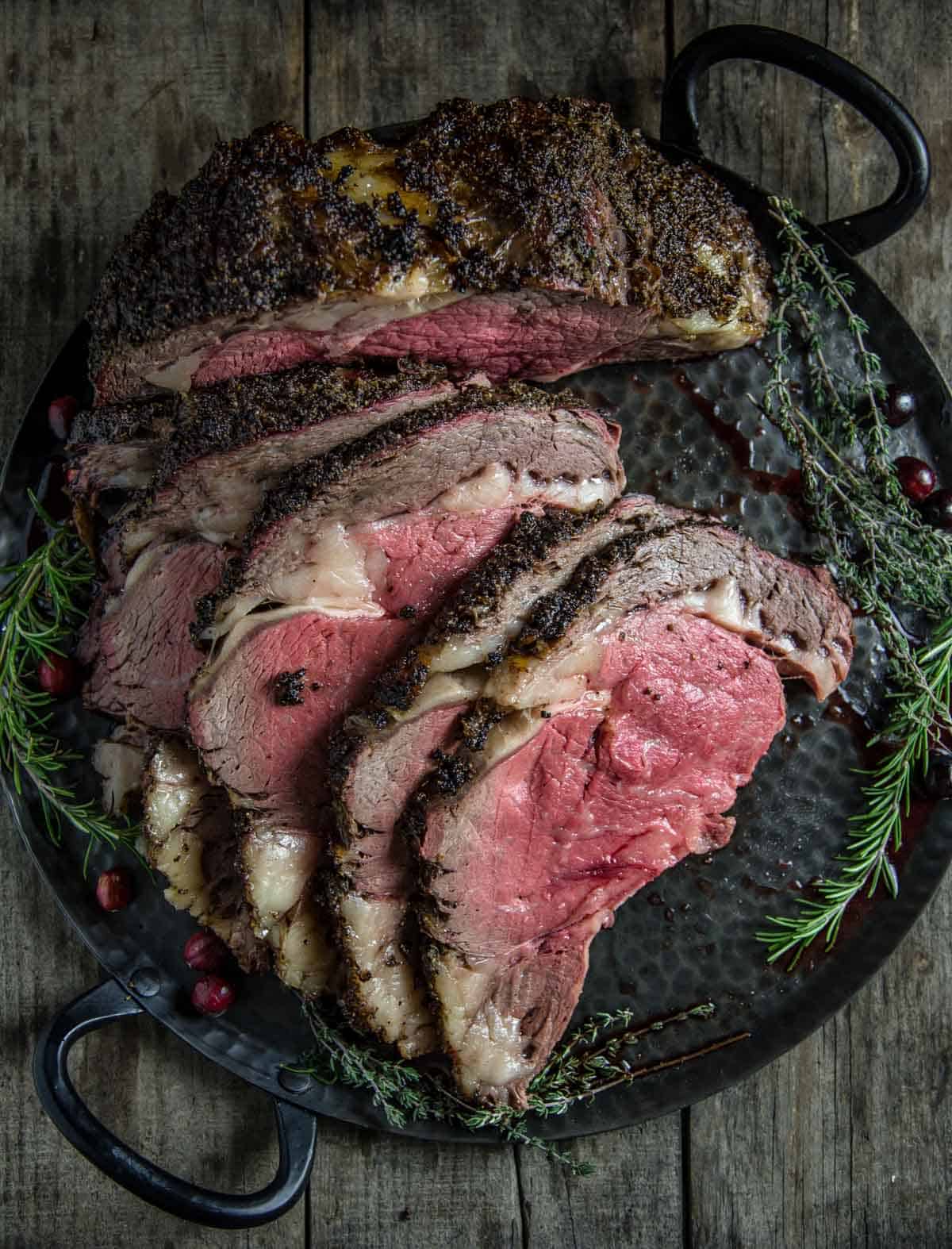
Prime Rib is one of the iconic celebratory holiday meals, especially on Christmas. It’s dramatic, big in flavor, and delicious. There are many ways to make it, that can include Grilled Prime Rib or even Reverse-Seared Prime Rib. If you are cooking this special occasion recipe for family or friends this holiday season this is your go-to guide for smoking the perfect roast.
Table of Contents
Smoked Prime Rib Ingredients
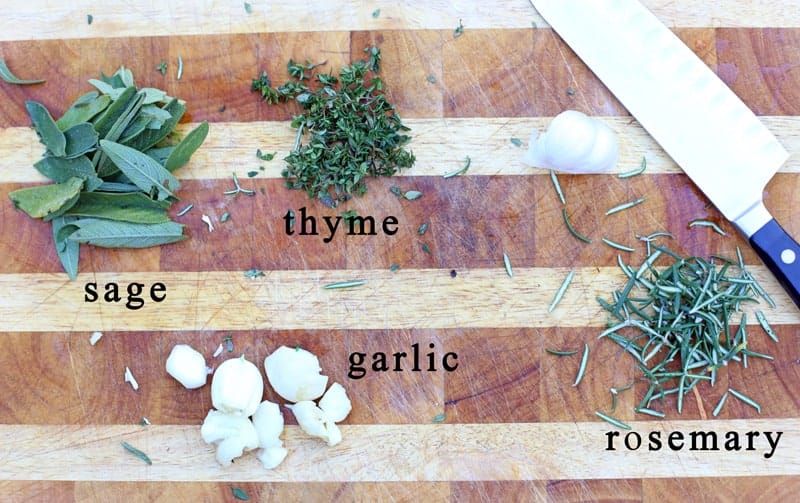
- Prime Rib: You can use a boneless or a bone-in prime rib or rib roast. We prefer bone-in as the bone protects the bottom of the roast.
- Olive Oil: We add a little olive oil on the outside of the rib roast as a binder for the seasoning and the herb paste.
- Seasoning: We like to keep it simple, with even parts of kosher salt and coarse black pepper. Alternatively, you can use our SPG Rub, which adds granulated garlic. Or for a real savory flavor use our Beef Seasoning.
- Herb Paste: The paste is a mix of extra virgin olive oil, fresh garlic, rosemary, thyme, and sage. The aromatics are great in the smoker. If you don’t like any one of those flavors you can leave it out. Just be sure you keep the same total portions for fresh herbs.
Selecting A Roast
- Select the Size of Roast: When shopping for a roast for an event or party, we plan 1 pound of prime rib per person (pre-cook weight).
- What is your Budget: Having a budget can help guide where you want to find the most quality for the money. Look online if you aren’t finding what you want locally.
- Consider the Marbling: Look at the intramuscular fat. Be sure there is healthy marbling, but still a good amount of meat.
- Bone-In or Boneless: If buying bone-in, typically order the roast by number of rib bones, like a 3-bone rib roast. Bone-in has the benefit of a layer between the heat source and the meat to protect the meat while cooking.
There is no flavor difference between bone-in or boneless (so don’t let anyone tell you there is). The difference comes in presentation and having a small layer between the grill, the bones, and the rib roast.
The flavor differences are going to be defined by the quality of meat and marbling vs. whether or not your roast is boneless or bone-in.
Wait – Isn’t Prime Rib Prime Quality?
Prime Rib does not technically mean “Prime graded”. Prime refers to the primal cut, or the first cut that butchers make from cattle. Quality, as defined by the USDA, is the marbling quality of beef like choice versus prime, which in turn also impacts tenderness and flavor.
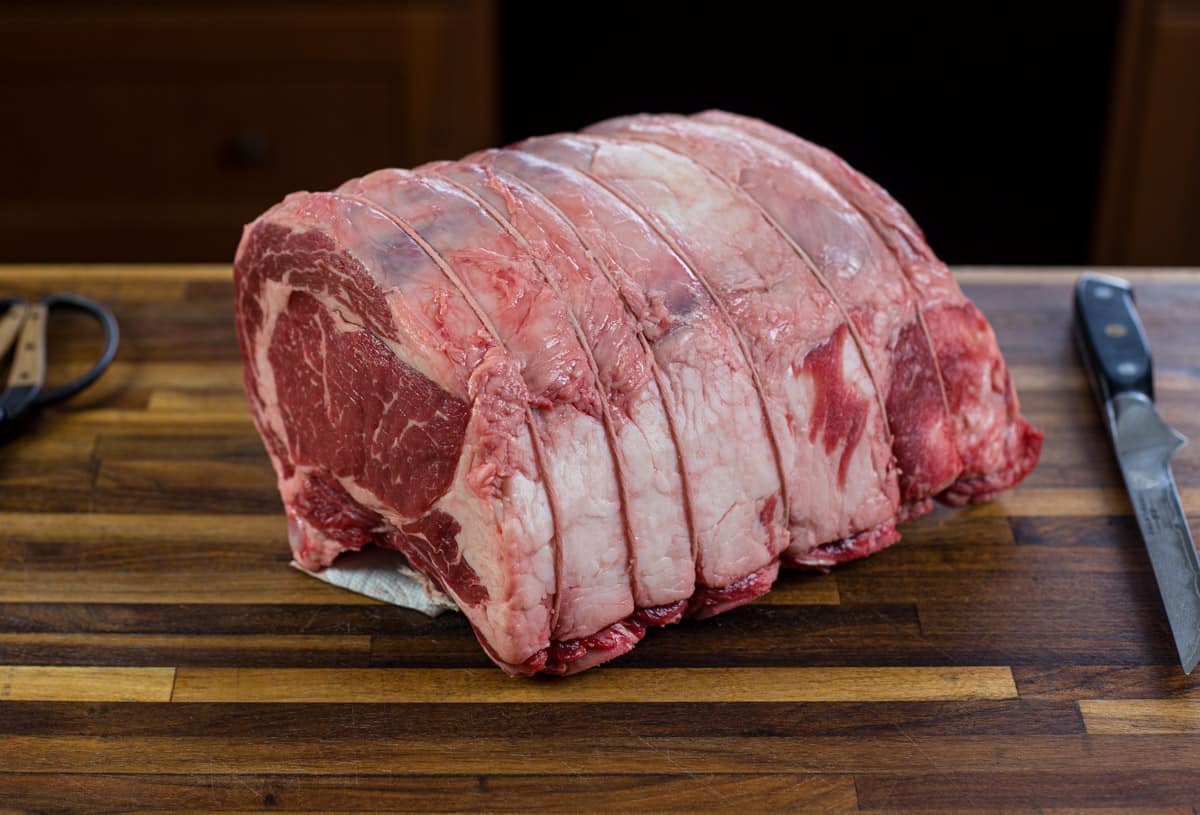
In order of grade of beef quality per USDA you have Prime, Choice, and then Select.
While Prime is considered the highest quality, Choice also has tremendous flavor and is certainly not “inferior” meat. It just didn’t rise to the occasion of marbling and quality as the Prime. When you get to Select, you begin to see a difference in the meat, the fat content, and other factors. It is still worthy of smoking, but I would be sure if going down this route, consider at least a Choice cut for a smoked prime rib.
You can also buy American Wagyu, like from Snake River Farms. The marbling for American Wagyu is equal to or above Prime. American Wagyu contains even more marbling and has an amazing buttery texture that is incredible.
At some stores, you may see labels outlining the rancher, or the type of feed (grass, grain, etc.). Don’t hesitate to ask if the beef is rated, and if it isn’t, at least discuss with the butcher that you are looking for a Choice or Prime quality cut or its equivalent. Grain finishing adds marbling. Strictly grass-fed beef will tend to be leaner and with less marbling.
Finally, look closely at the labeling. In the end, it may say “Prime Rib of Beef” or “Standing Beef Rib Roast for Prime Rib” according to the USDA but not have to be derived from Prime-grade beef. So when in doubt ask the butcher.
Preparation
Your prime rib may come with the bones removed by the butcher, or with the bones attached. It is really a personal preference. In our experience, it’s easier to separate the bones before the roast is cooked, and then tie them back together using butcher twine.
- Trim Excess Fat: Start by trimming the excess fat cap off the outer roast if it is hanging or loose. There is plenty of marbling inside to give flavor. Removing excess fat helps get the seasoning closer to the meat.
- Pat Dry: After trimming the fat, pat the roast dry.
- Tie: If the bones have not been removed do it now, before seasoning and before smoking. Then tie them back together with butcher twine.
Prime Rib Seasoning
Start with a coat of olive oil and then add kosher salt and black pepper. Sound simple? It is, and this is due to the amazing flavor you get from the fat rendering as you slowly cook the meat.
Want to add another layer of flavor? Consider a flavorful herb paste of olive oil, crushed garlic, thyme, sage, and rosemary for your Smoked Prime Rib, such as the one below.
A paste is simply a wet rub. Just blend all of the ingredients together in a food processor. It sticks easier to the meat, and when using smoke, the moisture from the paste helps the flavor adhere to the meat.
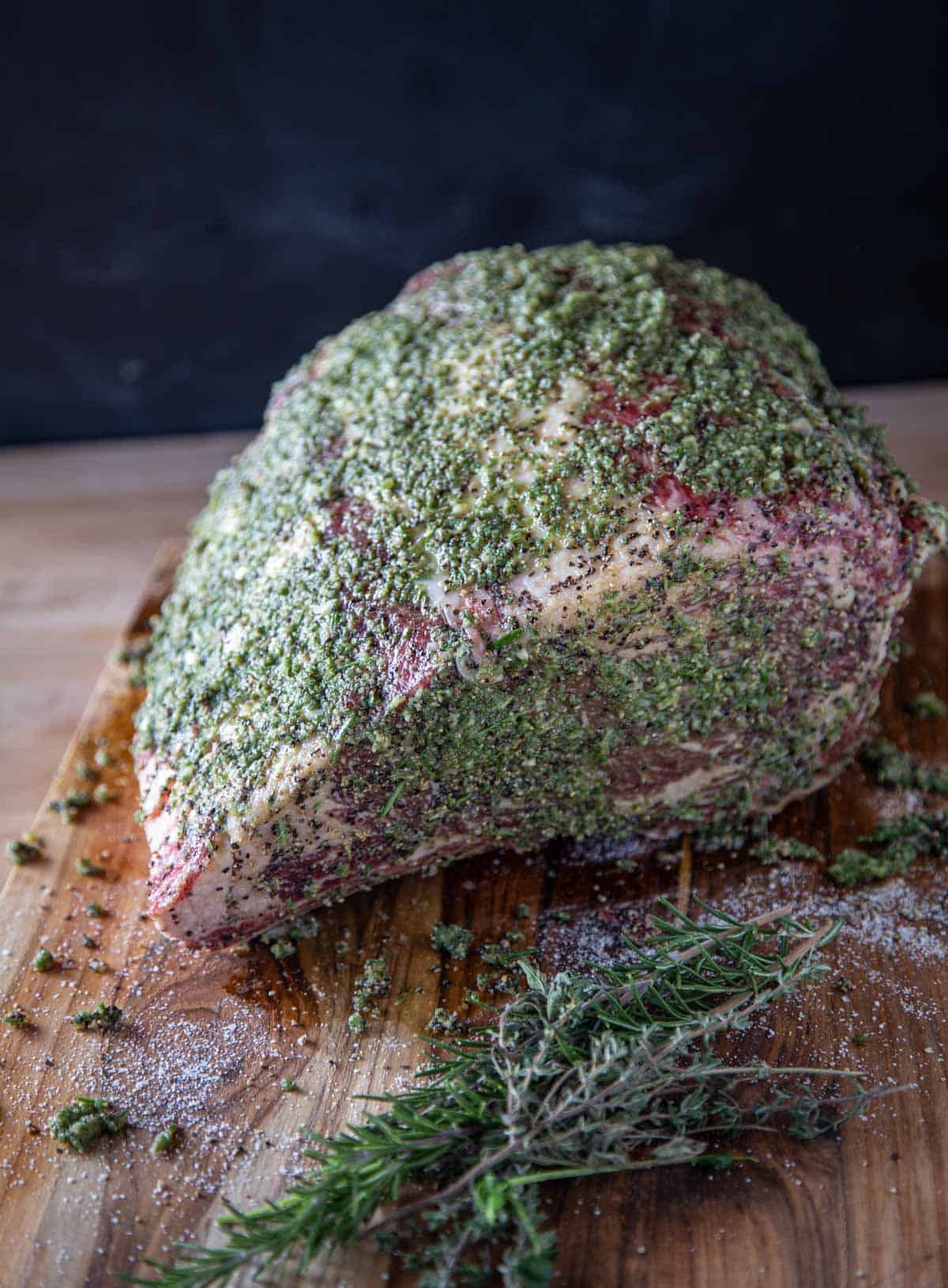
Remember to also season within that area of the bone that was removed by the butcher, and coat everywhere. Seriously, be LIBERAL with your paste and seasonings!
Double this herb paste recipe if the roast is over 5 pounds.
How to Smoke a Prime Rib
The process for smoking prime rib is the same whether you use a pellet smoker or Big Green Egg.
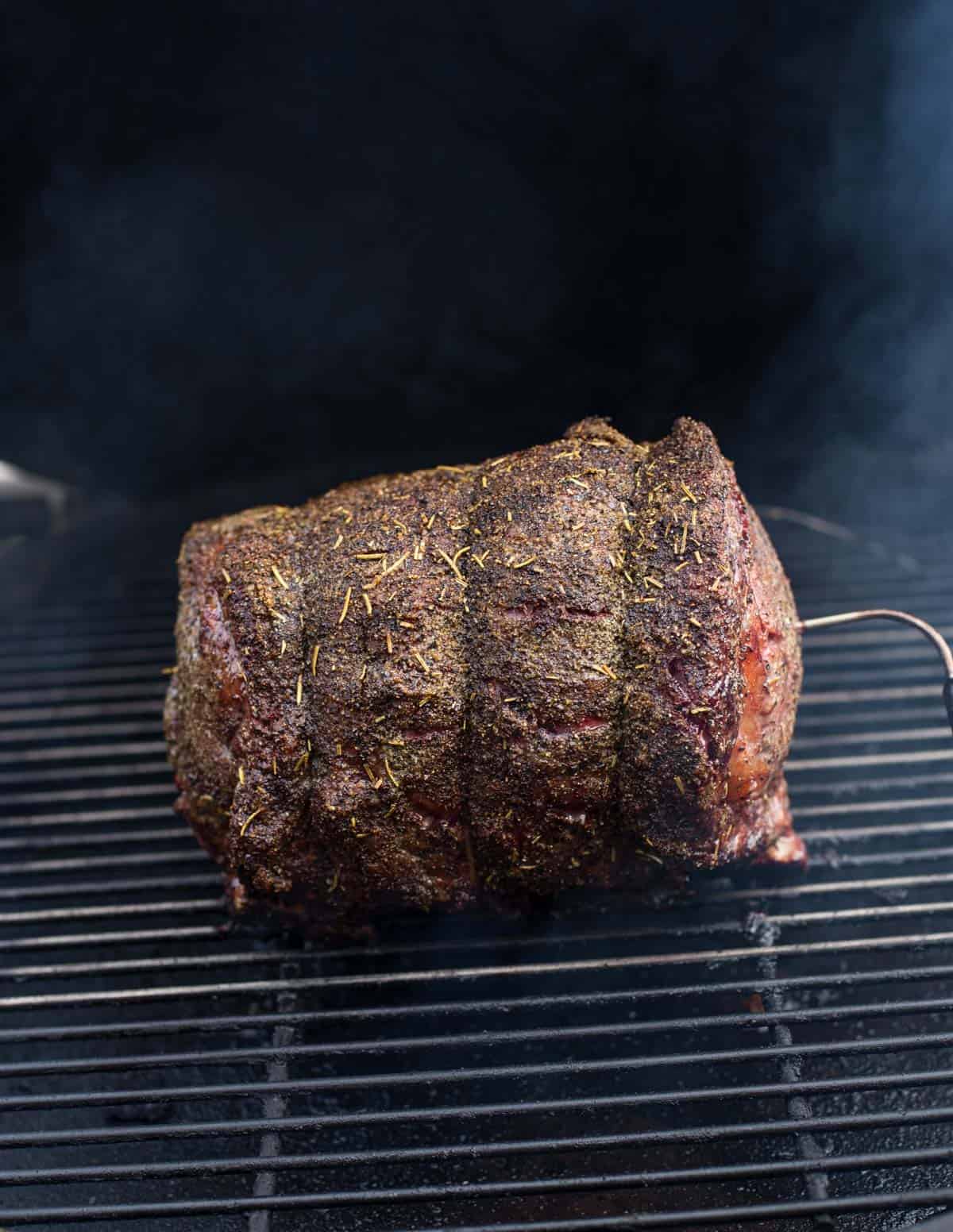
- Preheat Smoker: Set the smoker to 225 degrees, and keep this temperature consistent throughout the cooking process. We recommend using fruit wood or oak for a balanced smoky flavor.
- Smoke Prime Rib: Place the seasoned prime rib roast onto the smoker when the smoker comes to temperature. Insert any meat probe from your leave-in thermometer like the Thermoworks Smoke Unit. Smoke the roast until the internal temperature of the meat, when measured at the center, is at your desired level; I like 125 degrees for rare and 135 for medium rare when using a good instant read thermometer.
- Rest: Once you pull the roast from the smoker, tent the roast loosely in aluminum foil and allow the meat to rest for 30 minutes. The temperature will continue to rise another 5 degrees because of carry-over cooking and while the meat rests, the cells will reabsorb the juices as it cools keeping the sliced meat moist.
- Slice and Serve: Carve and serve with your favorite sides.
See the recipe card for more details on the temperature recommendations for the level of doneness. Or you can refer to our article on the perfect steak temperature.
Slicing + Serving
Remove the foil and then remove the strings (if you wrapped your roast). Next, remove the bones from the prime rib roast (see video for how we do this). As much as I love the bone, I find a much more elegant (and easier) presentation without the bone. Place the roast on a cutting board and slice to the desired thickness. Serve with your favorite sides.
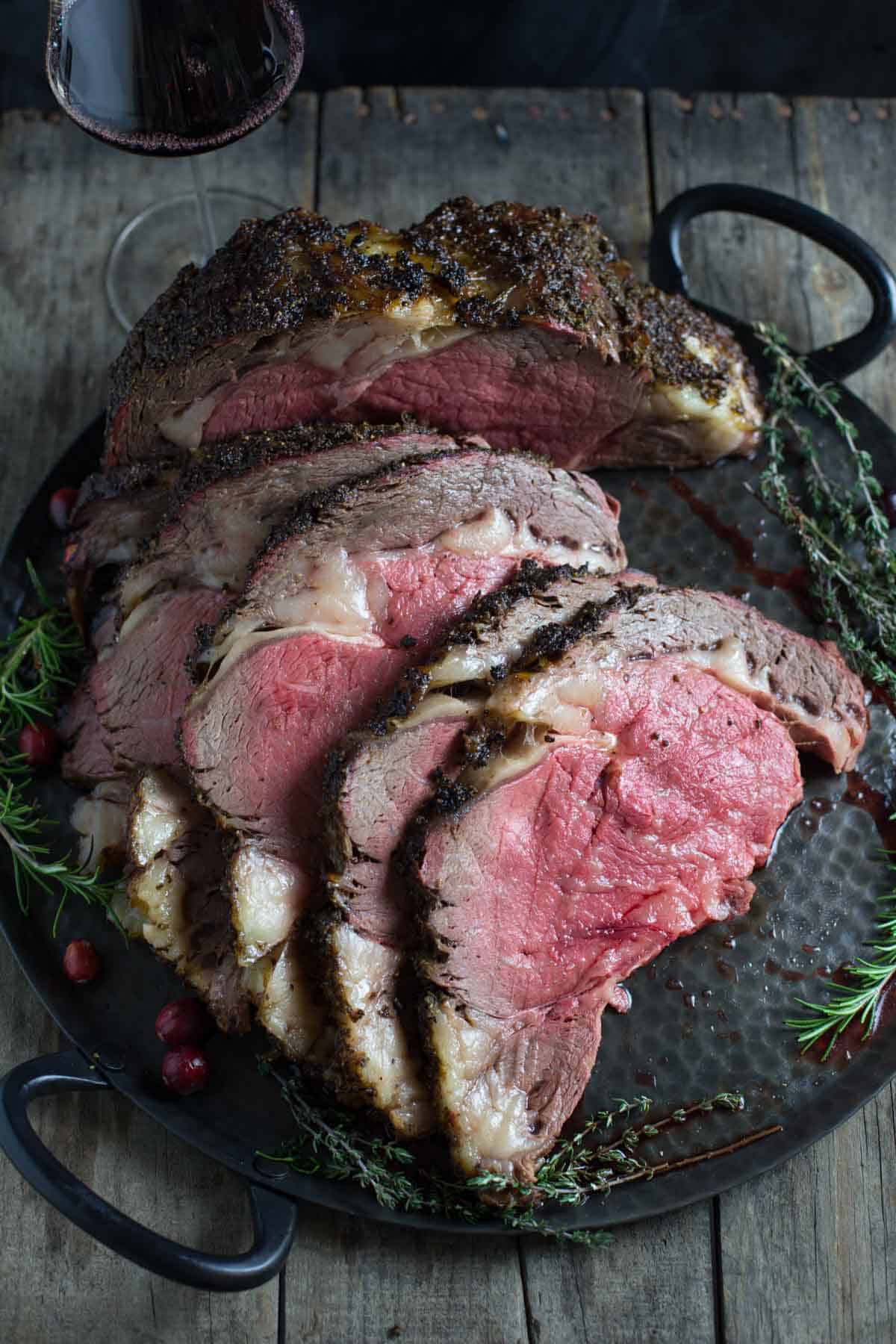
The great part of smoking a Prime Rib Roast is the ability to cook the outer edges to medium while the center can be rare. So you can please a wide audience without overcooking the entire roast if some of your guests prefer a more medium-well done slice.
If you want to add even more flavor consider finishing with a nice finishing salt or a compound butter.
Would you like to save this?
How Long to Smoke Prime Rib
Cooking times are based on a finished internal temperature of 130°F. Remember, the internal temperature of the prime rib – not the time – determines doneness when cooking at low temperatures.
- 225°F: ~40 minutes per pound
- 250°F: ~30 minutes per pound
- 275°F: ~20 minutes per pound
Approximate smoking times for prime rib at 225°F:
- 4 lbs: 2.6 hours
- 6 lbs: 4 hours
- 8 lbs: 5.3 hours
- 10 lbs: 6.6 hours
Chef’s Tip
Be sure to add 30 minutes of resting time to the cooking time for carry over cooking. If your rib roast is done early, then wrap the roast in butcher paper or a towel and place into a cooler with no ice. The roast will stay warm for up to four hours.
Frequently Asked Questions
We do not recommend wrapping a rib roast while smoking. Wrapping stops the infusion of smoke flavor and prevents a nice crust, or bark, from developing. We recommend smoking throughout the process unwrapped and loosely tenting in foil when resting.
The top of the prime rib will have the fat cap. We like to smoke so the fat cap is facing up throughout the smoking process. This allows some of the fat cap to render down and through the roast.
We recommend 225 degrees Fahrenheit for the most smoke flavor. It adds 10 more minutes of cooking time per pound versus 250 degrees. The most important is to use a good leave-in instant read thermometer and remove it when it reads an internal temperature of 125 degrees F and then let rest for carry-over cooking to occur.
Prime Rib Wine Pairing
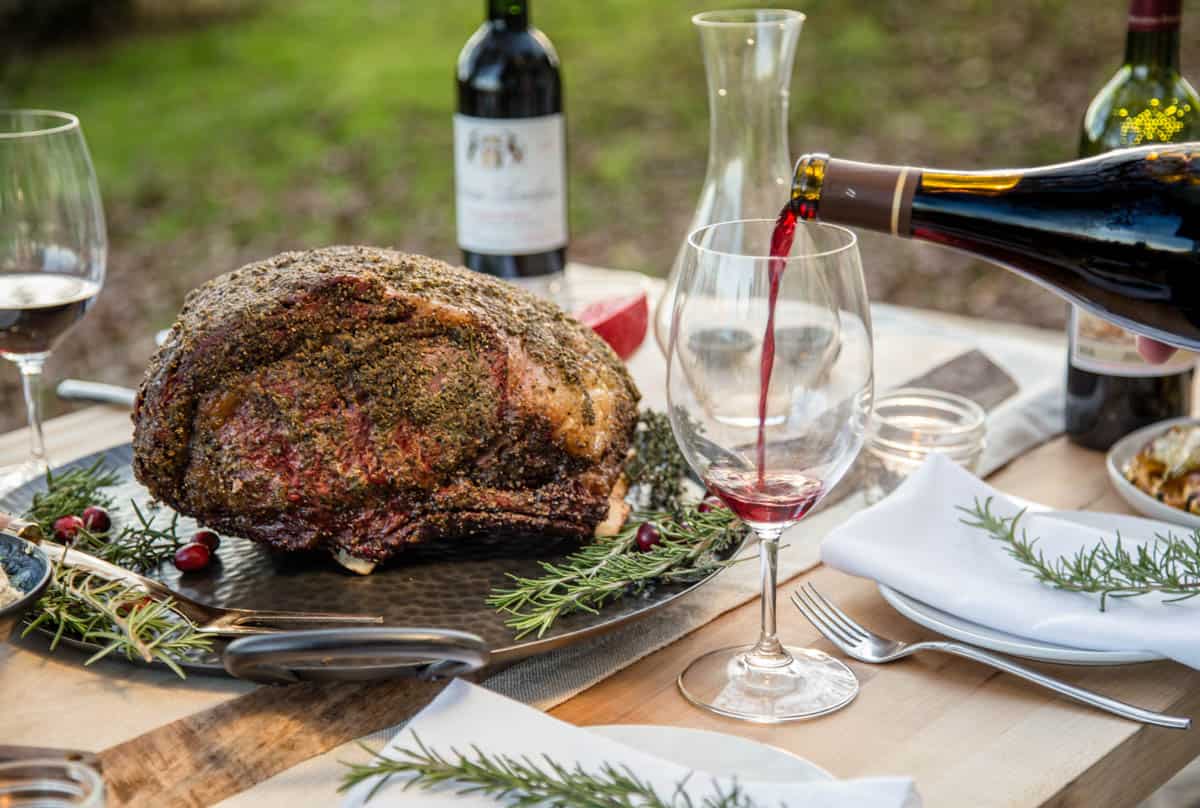
The best wine with Prime Rib is a big red such as a California Cabernet Sauvignon, Bordeaux, Merlot, or Malbec. You can read more about pairing wine with Beef Rib Roast, where we discuss all things wine and smoked prime rib.
Storage and Reheating Instructions
Prime rib will last up to five days in the refrigerator. Store in an airtight container. To reheat Prime Rib, use the following instructions.
On the Stovetop: Heat a large cast iron or stainless steel pan on the stovetop set to medium heat, and add olive oil or butter. Let warm until just about to smoke point. Add the slices and pan sear like a steak. Flip after a few minutes and sear the other side.
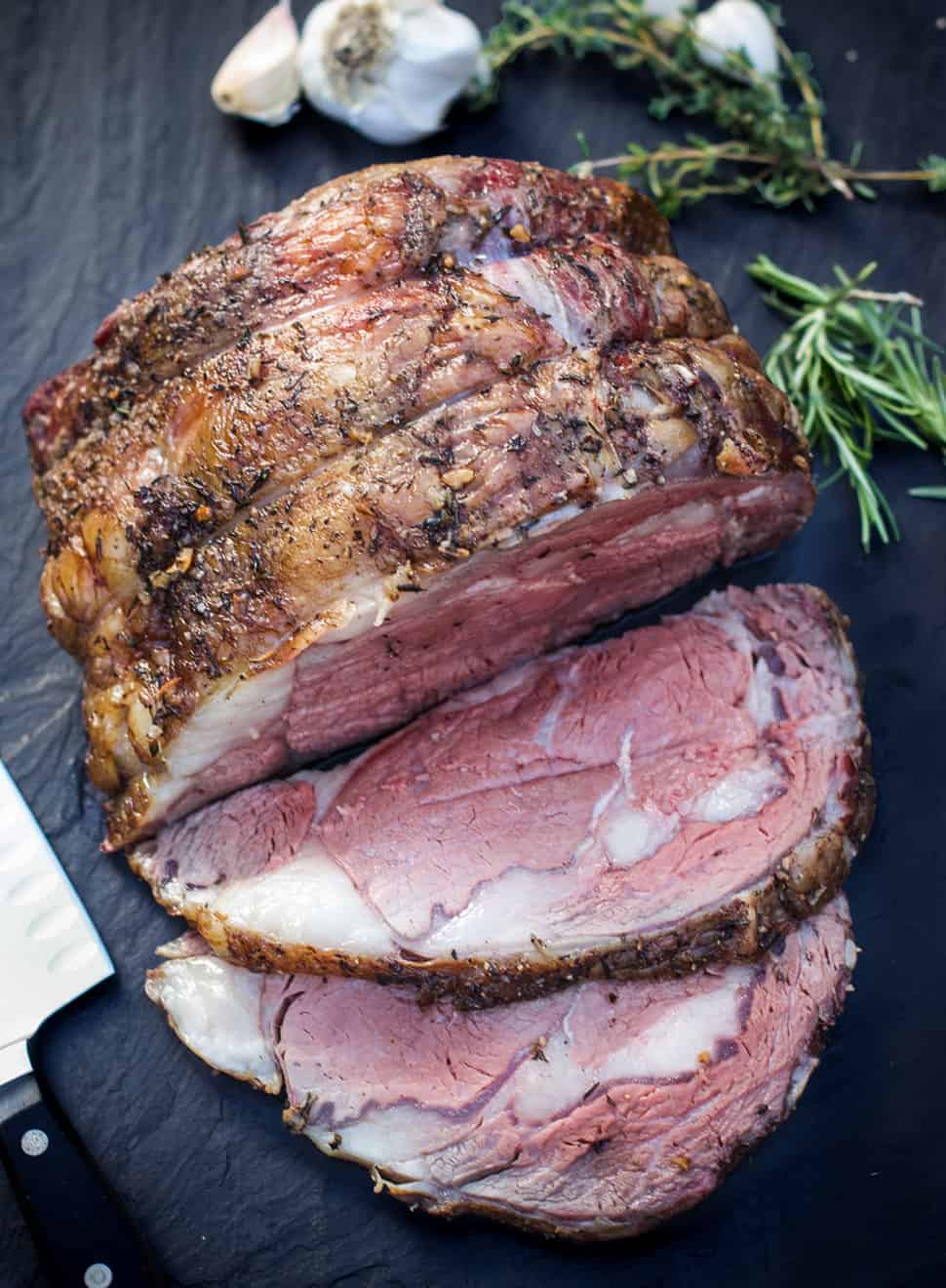
In the Oven: Preheat the oven to 400 degrees F. Wrap the rib roast or slices in aluminum foil. Place in the oven for 15 minutes and then serve warm.
Holiday Meal Planning Ideas
Explore our entire article on holiday recipes for the grill and smoker for more holiday roast inspiration, appetizers, and cocktails. Here are some of our favorites.
Leftover Prime Rib Ideas
If you end up with leftover prime rib then here are a few recipes for inspiration.
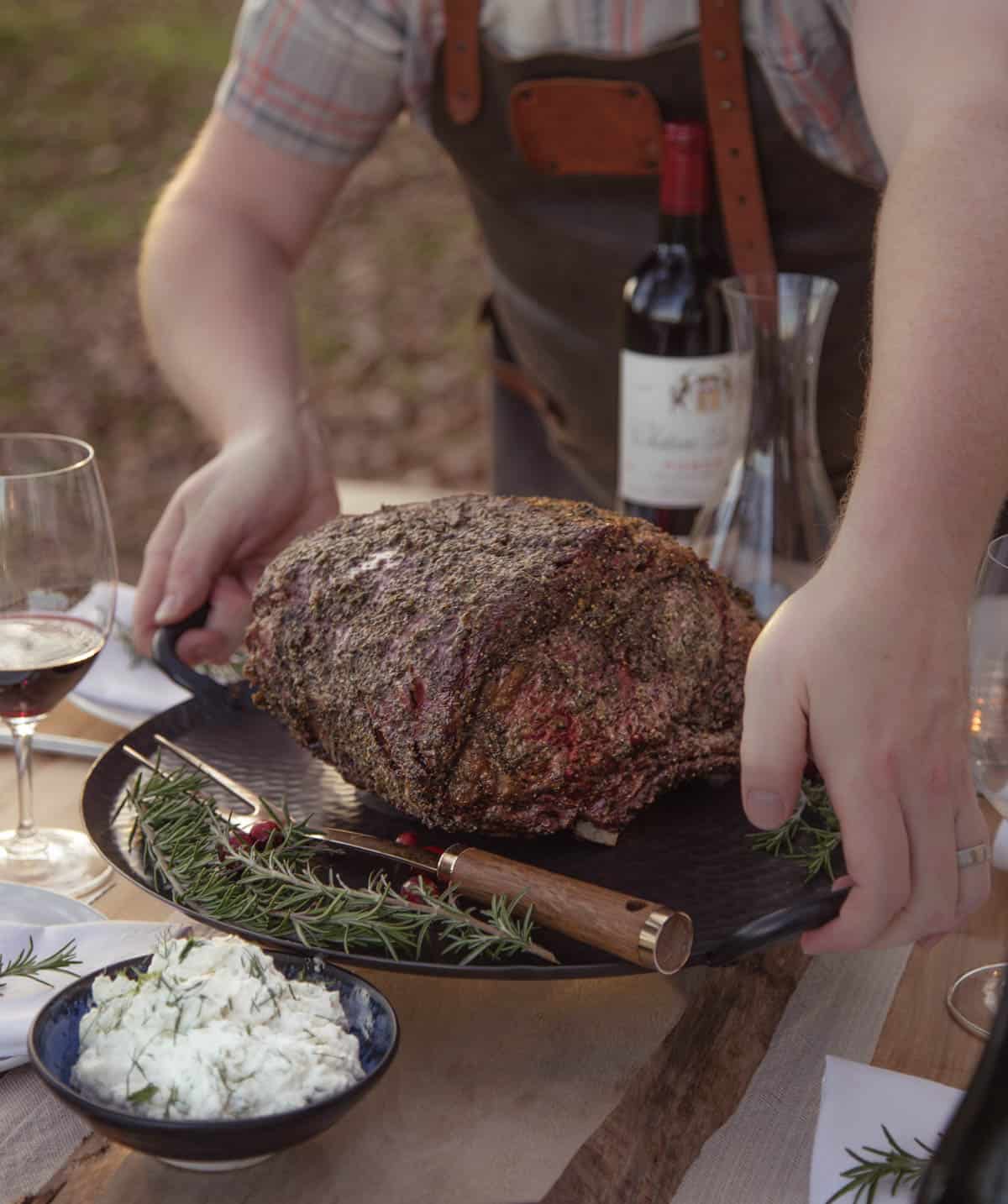
Tried this recipe? Give us a star rating and we would love to see! Mention @vindulge or use the hashtag #vindulge on all the social media handles. And consider subscribing to our newsletter where we drop all our favorite ideas and inspirations every week.
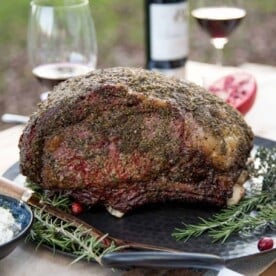
Smoked Prime Rib Recipe
Ingredients
For the Prime Rib:
- 5 pound Prime Rib Roast (or rib roast)
- ¼ cup extra virgin olive oil
- 2 tablespoons coarse ground black pepper
- 2 tablespoons kosher salt
For the Herb Paste:
- 3 cloves of garlic
- 1 tablespoon fresh rosemary
- 1 tablespoon fresh thyme
- 1 tablespoon fresh sage
- ¼ cup extra virgin olive oil
Instructions
For the Herb Paste:
- Place all herb paste ingredients into a food processor and pulse a few times until combined into a chunky paste. (double recipe if roast is over 5 pounds)
For the Smoked Prime Rib:
- Prep Prime Rib: If the bone has already been removed, remove the string and bone to trim excess fat off of the meat, and pat dry. Using butcher's twine, tie the bones back onto the roast. If the bone has not been removed simply remove it after cooking.
- Season Roast: Apply olive oil, and then kosher salt and black pepper generously to the rib roast. Then apply the paste. Store overnight in the refrigerator to allow the seasoning to incorporate into the meat (if possible).
- Preheat Smoker: To 225 degrees using a fruit wood like apple or cherry (oak also works well).
- Smoke Roast: Place the seasoned rib roast on the smoker, bone side down (this acts as a heat shield). Insert any Bluetooth thermometer at this time to monitor the ongoing temperature of the roast while cooking, like the Thermoworks Smoke Unit.
- Continue cooking the roast for roughly 3 1/2 hours or until the center of the meat reads 125 degrees F using an instant-read thermometer for rare. (At 225 degrees plan 40 minutes of cooking time per pound). Use an instant-read thermometer to probe in multiple areas toward the center of the cut. See notes for the temperature chart.
- Rest: Remove Prime Rib from smoker and let sit, tented in foil, for 30 minutes.
- Slice and serve.
Video
Notes
- Rare: 120-130 degrees F
- Medium Rare: 130-140 degrees F
- Medium: 140-150 degrees F
- Medium Well: 150-160 degrees F
- Well Done: 160 degrees F (and not recommended)
Nutrition
Nutrition information is automatically calculated, so should only be used as an approximation.
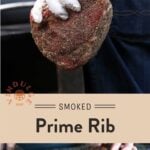
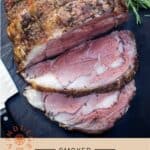
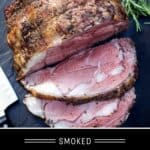
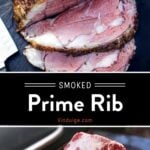

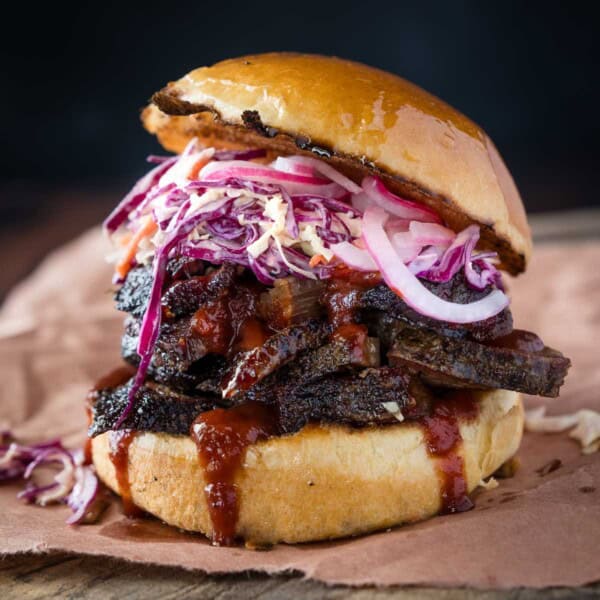
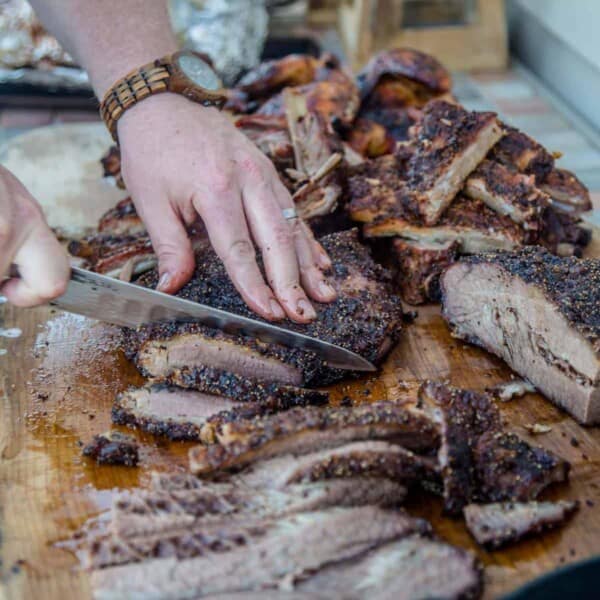
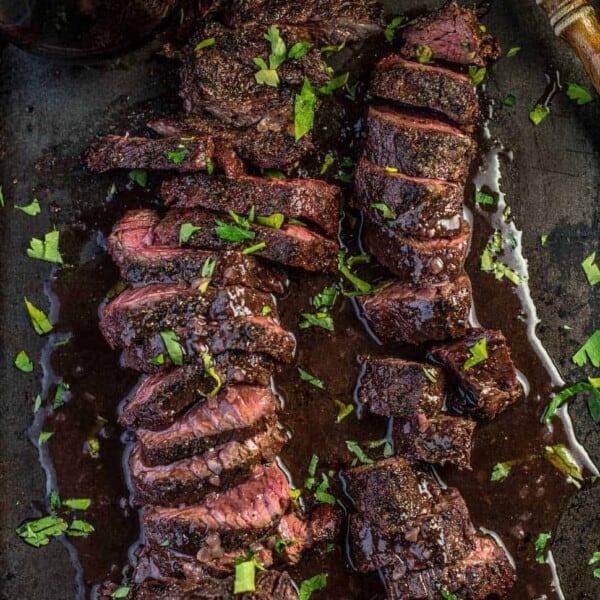
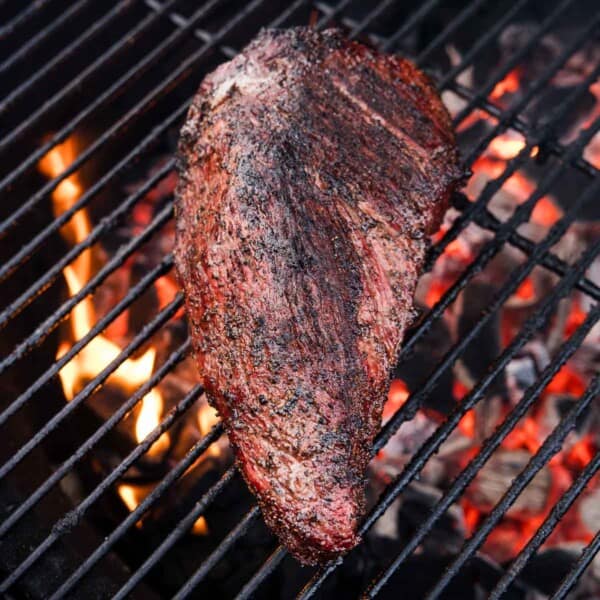
















4 Pound Prime Rib = 2.6 hours
6 pound Prime Rib = 4 hours
8 pound Prime Rib = 5.3 hours
10 pound Prime Rib = 6.6 hours
When using these times, are you calculating the weight of the meat with or without the bones attached?
It will always be based on temperature versus time, but generally it’s with a bone-in rib roast.
Awesome recipe! I was going to try a few different ones but after we used this one the first time, we’ve never tried another. We grow our own herbs which probably makes it even better.
Herb paste added a ton of flavor
Happy New Year! Love your recipes. We’re smoking a prime rib today in our Mak Two Star General. It’s the best!
YESSSS Cathy!!! Thanks so much for following along and for the note.
Was nervous about smoking such an expensive cut of meat, until I watched your video. You made it look easy and it was! Was perfect for Christmas dinner. Thank you.
Tried it on my new Traeger smoker and it came out fantastic. Thanks mucho!
Congrats an your outdoor cooking investment! And thank you for the feedback!
Unless I missed it, you never described the wood used for smoking your Prime
It’s actually in the recipe details – we recommend a fruit wood like apple or cherry for the sweeter flavor. Oak works too. Hickory and Mesquite will certainly be a lot more smokier, which is why we like the lighter woods.
Hi there from Sonora CA!
We just finished dinning on a Thanksgivings Prime Rib from your recipe. It was freaking delicious, perfectly cooked, 9 lbs. for 4 hours (127deg f.). Internal. We were a little early based on cooking at 225deg at 40 mins per lb. but it held well rapped in foil, towels and a blanket after taking off the CampChef smoker.
Oh baby so good!!!
Cheers
Jerry
PS: we had an organic table mountain beef prime rib from Rawhide meats. Get the grass fed organic for optimum taste!!!!!
Thank you for taking time to share your feedback and we are so glad it turned out! And that grass fed beef sounds like it was amazing.
Thank you for this recipe. We are doing a new tradition for Thanksgiving as my husband passed away in may fighting a battle of COPD for years. So, my son and I are learning how to Smoke (which I bought last year and my neighbor’s husband put it together for me) and BBQ. I use my Instant Pot and Ninja Foodi, but, we hardly every BBQ’d and I am loving it. Teaching my 20-year old son, and he smoked a Salmon on his own, and turned out pretty good. Was proud of him.
Kerri, first we are so sorry for your loss. What a great experience with your son to be able to cook together. We believe that cooking for and with each other is an act of love and I am sure your husband is with you as you continue with your new traditions. Thank you for sharing.
Happy Thanksgiving Mary!
You knocked it out of the park with this recipe, and just helped us establish our yearly holiday tradition. I think turkey is taking a backseat.
Our family is a little pickier, and we smoked our 7 pound roast to medium doneness, in about 4.5 hours (143 degrees). Outstanding results! Thanks for the recipe!